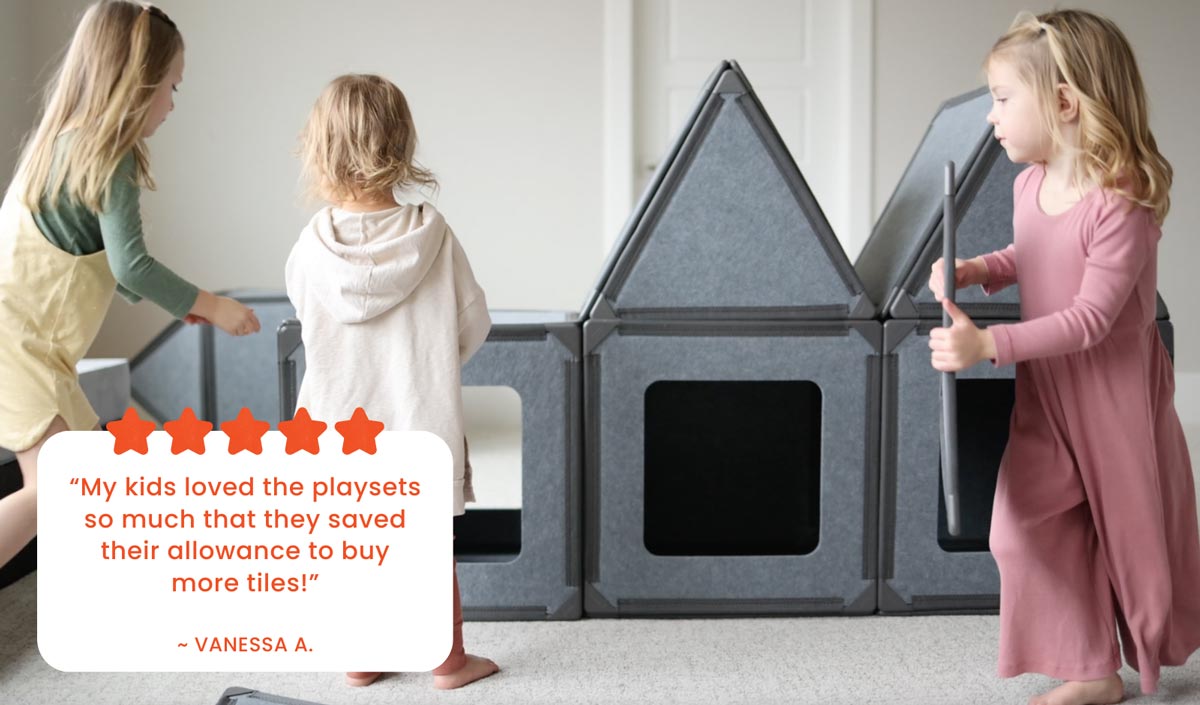The Power of Vertical Play: How Vertical Surface Learning Boosts Memory Retention
Becky WilsonIn early childhood education, one often overlooked dimension of learning is vertical surface learning—interactions on upright surfaces like easels, chalkboards, and magnetic walls. While vertical play supports motor development, it's also a powerful cognitive tool that enhances memory retention and learning in young children.
Research in embodied cognition shows that when children engage their whole body through vertical surfaces, they create stronger, more lasting memories than with traditional tabletop activities. For parents and educators, Superspace's giant magnetic tiles create life-sized vertical surfaces that encourage kinesthetic engagement and memory retention while keeping learning playful.
This guide explores the science behind vertical surface learning and shares practical activities you can start today to unlock the cognitive benefits of vertical play.

Key Takeaways
- Vertical surface learning engages embodied cognition, helping children encode information more deeply through full-body interaction with learning materials.
- Standing and moving during vertical play increases blood flow and alertness, directly improving attention and memory formation in young learners.
- Spatial memory is strengthened when children associate information with physical locations on vertical surfaces, making recall easier and more effective.
- Kinesthetic learning activities on vertical surfaces create strong neural pathways through movement-based memory encoding, especially beneficial for ages 3-7.
- Multisensory learning through vertical play, including verbal reinforcement and social interaction, leads to more durable memory retention than traditional seated activities.
Table of Contents
- Embodied Learning: Engaging the Whole Body for Deeper Memory Formation
- Alertness and Attention: The Foundation of Memory
- Spatial Anchoring and Visual Memory
- Kinesthetic Learning for Kids: How Movement Improves Memory Encoding
- Social Learning and Verbal Recall
- When Vertical Surface Learning Matters Most
- 10 Vertical Surface Learning Activities to Try at Home
- The Power of Movement-Based Learning
- References
Embodied Learning: Engaging the Whole Body for Deeper Memory Formation
Vertical surface learning engages a child's entire body in the learning process. Reaching, stretching, and stabilizing at a vertical surface naturally incorporates embodied cognition, a theory suggesting that cognitive processes are deeply rooted in the body's interactions with the world.
According to Barsalou (2008), when children physically interact with materials—like tracing letters on a window or manipulating magnets on a board—they encode information in a more meaningful and lasting way. This full-body involvement in kinesthetic learning activities supports not only physical coordination but mental encoding of new concepts.
Unlike seated desk work, vertical play requires children to stand, reach, and move continuously. This active engagement turns abstract concepts into physical experiences, creating multiple pathways for memory storage and retrieval.

Alertness and Attention: The Foundation of Memory
The act of standing during vertical surface learning increases blood flow and oxygen to the brain, enhancing alertness and attention. These physiological changes are important because they directly affect how children take in and process information.
The more attention children give to a learning task, the more likely it is to be stored in long-term memory. This connection between movement and memory is why kinesthetic learning for kids through activities like easel painting or window writing can feel more engaging and novel than tabletop tasks.
Research shows that when children are physically active during learning, their brains are better prepared to encode and retain new information. Vertical play naturally maintains this state of alertness, supporting cognitive development through sustained engagement.
Spatial Anchoring and Visual Memory
Vertical surfaces allow for spatial placement of information, which supports spatial memory. Children begin to associate certain information with a physical location—placing numbers in sequence across a wall, for example—which creates mental maps that make it easier to retrieve the information later.
This principle is similar to the well-known memory technique called the method of loci, where individuals remember information by associating it with specific locations. When children engage in vertical surface learning, they're naturally using this powerful memory strategy.
Moreover, working at eye level supports visual tracking and visual spatial awareness, which are key components of reading and early math skills. As children visually scan a board from left to right, they build skills aligned with print tracking and symbol recognition.
The vertical format also allows for larger, more visible work spaces. This expanded visual field helps children see patterns, relationships, and sequences more clearly than cramped paper-based activities, enhancing both understanding and memory retention.

Kinesthetic Learning for Kids: How Movement Improves Memory Encoding
Young children are kinesthetic learners by nature—they learn best by doing. Vertical surface learning enables kinesthetic encoding, where movement becomes part of the memory.
For instance, when a child places magnetic letters to spell a word on a vertical surface, the movement involved in locating and placing each letter contributes to the memory of the word itself. This kind of procedural learning builds strong neural pathways, especially in early learners whose brains are still developing foundational cognitive systems.
The physical act of reaching up, stretching across, and moving along a vertical surface creates what researchers call "motor memory." This embodied learning approach means that children aren't just seeing or hearing information—they're experiencing it through their entire body, creating multiple memory traces that support long-term retention.
Studies show that kinesthetic learning activities produce more durable memories than passive learning because the brain encodes both the information and the physical experience of learning it. When children later need to recall that information, the body's memory of the movement helps trigger cognitive recall.
Social Learning and Verbal Recall
Vertical surface learning often promotes peer interaction and verbalization, especially when children work side-by-side at a shared easel or wall chart. These social dynamics lead to verbal reinforcement, where children talk through what they're doing, ask questions, and explain their thinking aloud.
According to Shams and Seitz (2008), learning that incorporates multiple senses—including auditory input through verbal exchange—leads to more durable memory formation. This multisensory learning approach is naturally built into vertical play experiences.
When children explain their work to peers or teachers while at a vertical surface, they're engaging in elaborative rehearsal, a proven technique for strengthening memory. The combination of physical movement, visual processing, and verbal expression creates a powerful learning experience that supports cognitive development across multiple domains.
The upright, face-forward position of vertical play also facilitates eye contact and social engagement more naturally than hunched tabletop work, promoting communication skills alongside memory retention.

When Vertical Surface Learning Matters Most
The vertical play benefits are particularly impactful during the early years—ages 3 to 7—when children are developing core cognitive and motor functions. This is the critical window when embodied cognition principles have the greatest impact on learning.
Vertical surface learning is especially effective for:
- Introducing new concepts in literacy and numeracy
- Supporting children with attention or sensory processing needs
- Reinforcing learned skills through active engagement
- Building confidence in reluctant learners who struggle with traditional seated work
- Enhancing memory retention for children who learn best through movement
In essence, vertical play helps children move their bodies while activating their minds. By integrating movement, space, and social interaction, educators and parents can create learning environments that are not only developmentally appropriate but also optimized for cognitive development, memory retention, and long-term academic success.

10 Vertical Surface Learning Activities to Try at Home
Ready to incorporate vertical surface learning into your child's routine? Here are practical kinesthetic learning activities that boost memory retention and cognitive development:
1. Magnetic Letter Spelling Walls
Use magnetic letters on a refrigerator or magnetic board to practice spelling. The kinesthetic encoding of reaching and placing each letter strengthens word memory.
2. Easel Math Activities
Solve math problems on an easel or whiteboard. Writing numbers vertically helps children visualize mathematical relationships and supports spatial memory for number sequences.
3. Window Writing with Washable Markers
Let children write letters, numbers, or draw on windows with washable markers. The novelty and large-scale format enhance engagement and memory formation.
4. Chalkboard Storytelling
Create stories on a large chalkboard, adding drawings and words together. This multisensory approach combines verbal, visual, and kinesthetic learning for better retention.
5. Vertical Puzzles and Pattern Matching
Mount puzzles or pattern-matching activities on vertical boards. The upright position engages core muscles and increases alertness during problem-solving.
6. Contact Paper Collages
Place contact paper (sticky side out) on a wall and provide various materials for children to create collages. This tactile, vertical experience supports embodied learning.
7. Felt Board Story Sequences
Use felt boards to sequence story events or practice ordering. The physical manipulation on a vertical surface reinforces narrative memory and sequencing skills.
8. Wall-Mounted Number Lines
Create number lines on walls for counting, addition, and subtraction. Walking along the line while solving problems adds physical movement to mathematical thinking.
9. Vertical Art and Labeling
Paint or draw on easels, then add written labels to artwork. Connecting visual creation with written language strengthens literacy skills through embodied cognition.
10. Standing Sensory Writing
Fill shallow trays with sand, salt, or shaving cream and mount them vertically. Letter formation in these materials engages multiple senses for stronger memory traces.
These vertical play activities transform everyday learning into engaging, movement-based experiences that naturally enhance memory retention and cognitive development.

The Power of Movement-Based Learning
Vertical surface learning offers a simple yet powerful shift in how children engage with educational content. By incorporating movement, spatial awareness, and multisensory input, vertical play transforms abstract concepts into physical experiences that children's brains are designed to remember.
The research is clear: embodied cognition, kinesthetic encoding, and active engagement create stronger, more durable memories than passive learning. Whether you're a parent setting up a home easel or an educator redesigning classroom spaces, vertical surfaces provide an accessible tool for enhancing cognitive development and academic success.
Start small—a chalkboard, a window, or a magnetic board—and watch as children naturally lean into this engaging, movement-rich approach to learning.
References
- Barsalou, L. W. (2008). Grounded cognition. Annual Review of Psychology, 59, 617–645. https://doi.org/10.1146/annurev.psych.59.103006.093639
- Shams, L., & Seitz, A. R. (2008). Benefits of multisensory learning. Trends in Cognitive Sciences, 12(11), 411–417. https://doi.org/10.1016/j.tics.2008.07.006
- Medina, J. (2014). Brain Rules for Baby: How to Raise a Smart and Happy Child from Zero to Five. Pear Press.














